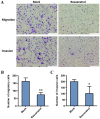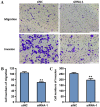Resveratrol suppresses the invasion and migration of human gastric cancer cells via inhibition of MALAT1-mediated epithelial-to-mesenchymal transition
- PMID: 30783423
- PMCID: PMC6364244
- DOI: 10.3892/etm.2018.7142
Resveratrol suppresses the invasion and migration of human gastric cancer cells via inhibition of MALAT1-mediated epithelial-to-mesenchymal transition
Abstract
Resveratrol, a natural polyphenolic phytoalexin, was reported to exert multiple anticancer effects as a traditional Chinese medicine. However, research regarding the anticancer mechanism of resveratrol for the treatment and prevention of gastric cancer has reported conflicting results. In the present study, it was determined that resveratrol inhibited cell viability in a dose-dependent manner in the human gastric cancer cell line BGC823. Cell migration and invasion were suppressed significantly following treatment with 200 µM resveratrol. Additionally, resveratrol inhibited metastasis-associated lung adenocarcinoma transcript 1 (MALAT1) expression, which was overexpressed in gastric cancer cells. Further experiments revealed that MALAT1 knockdown suppressed cell viability, migration, invasion and epithelial-to-mesenchymal transition in BGC823 cells. The present study indicated that resveratrol inhibited migration and invasion in human gastric cancer cells via suppressing MALAT1-mediated epithelial-to-mesenchymal transition, providing novel evidence for understanding the anticancer mechanism of resveratrol.
Keywords: epithelial-to-mesenchymal transition; gastric cancer; invasion; metastasis-associated lung adenocarcinoma transcript 1; migration; resveratrol.
Figures







Similar articles
-
Resveratrol inhibits the hedgehog signaling pathway and epithelial-mesenchymal transition and suppresses gastric cancer invasion and metastasis.Oncol Lett. 2015 May;9(5):2381-2387. doi: 10.3892/ol.2015.2988. Epub 2015 Feb 26. Oncol Lett. 2015. PMID: 26137075 Free PMC article.
-
Resveratrol inhibits TGF-β1-induced epithelial-to-mesenchymal transition and suppresses lung cancer invasion and metastasis.Toxicology. 2013 Jan 7;303:139-46. doi: 10.1016/j.tox.2012.09.017. Epub 2012 Nov 9. Toxicology. 2013. PMID: 23146760
-
Long non-coding RNA metastasis-associated lung adenocarcinoma transcript 1/microRNA-202-3p/periostin axis modulates invasion and epithelial-mesenchymal transition in human cervical cancer.J Cell Physiol. 2019 Aug;234(8):14170-14180. doi: 10.1002/jcp.28113. Epub 2019 Jan 11. J Cell Physiol. 2019. PMID: 30633360
-
Anti-metastatic potential of resveratrol and its metabolites by the inhibition of epithelial-mesenchymal transition, migration, and invasion of malignant cancer cells.Phytomedicine. 2016 Dec 15;23(14):1787-1796. doi: 10.1016/j.phymed.2016.10.016. Epub 2016 Oct 27. Phytomedicine. 2016. PMID: 27912881 Review.
-
Resveratrol and Its Analogs: Potent Agents to Reverse Epithelial-to-Mesenchymal Transition in Tumors.Front Oncol. 2021 Apr 16;11:644134. doi: 10.3389/fonc.2021.644134. eCollection 2021. Front Oncol. 2021. PMID: 33937049 Free PMC article. Review.
Cited by
-
Nanoformulations to Enhance the Bioavailability and Physiological Functions of Polyphenols.Molecules. 2020 Oct 10;25(20):4613. doi: 10.3390/molecules25204613. Molecules. 2020. PMID: 33050462 Free PMC article. Review.
-
Molecular mechanisms of resveratrol as chemo and radiosensitizer in cancer.Front Pharmacol. 2023 Nov 10;14:1287505. doi: 10.3389/fphar.2023.1287505. eCollection 2023. Front Pharmacol. 2023. PMID: 38026933 Free PMC article. Review.
-
Resveratrol Downregulates miR-155-5p to Block the Malignant Behavior of Gastric Cancer Cells.Biomed Res Int. 2022 Jun 25;2022:6968641. doi: 10.1155/2022/6968641. eCollection 2022. Biomed Res Int. 2022. PMID: 35789645 Free PMC article.
-
Modulation of hypoxia-inducible factor-1 signaling pathways in cancer angiogenesis, invasion, and metastasis by natural compounds: a comprehensive and critical review.Cancer Metastasis Rev. 2024 Mar;43(1):501-574. doi: 10.1007/s10555-023-10136-9. Epub 2023 Oct 4. Cancer Metastasis Rev. 2024. PMID: 37792223 Review.
-
Superporous hydrogels based on blends of chitosan and polyvinyl alcohol as a carrier for enhanced gastric delivery of resveratrol.Saudi Pharm J. 2023 Mar;31(3):335-347. doi: 10.1016/j.jsps.2023.01.001. Epub 2023 Jan 5. Saudi Pharm J. 2023. PMID: 37026050 Free PMC article.
References
-
- Takaoka M. Resveratrol, a new phenolic compound, from Veratrum grandiflorum. J Chem Society Japan. 1939;60:1090–1100.
LinkOut - more resources
Full Text Sources
